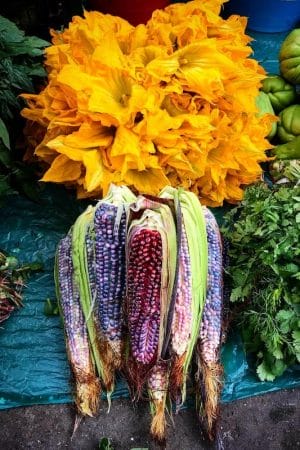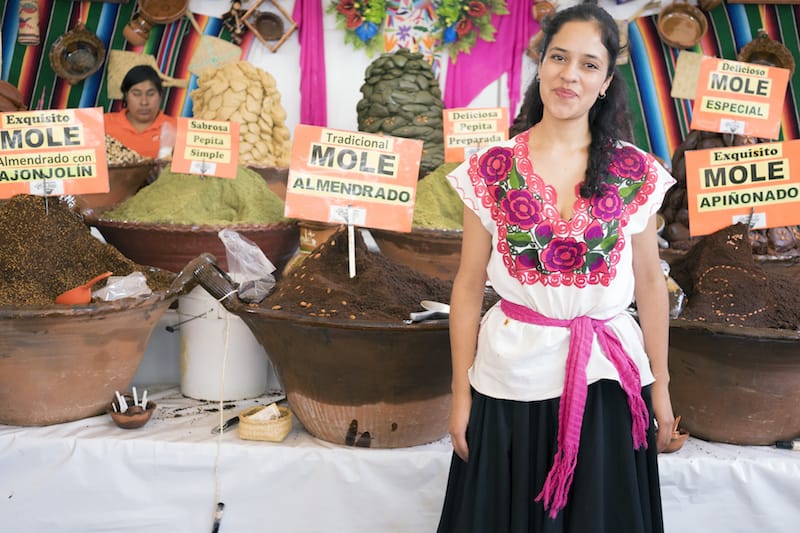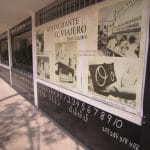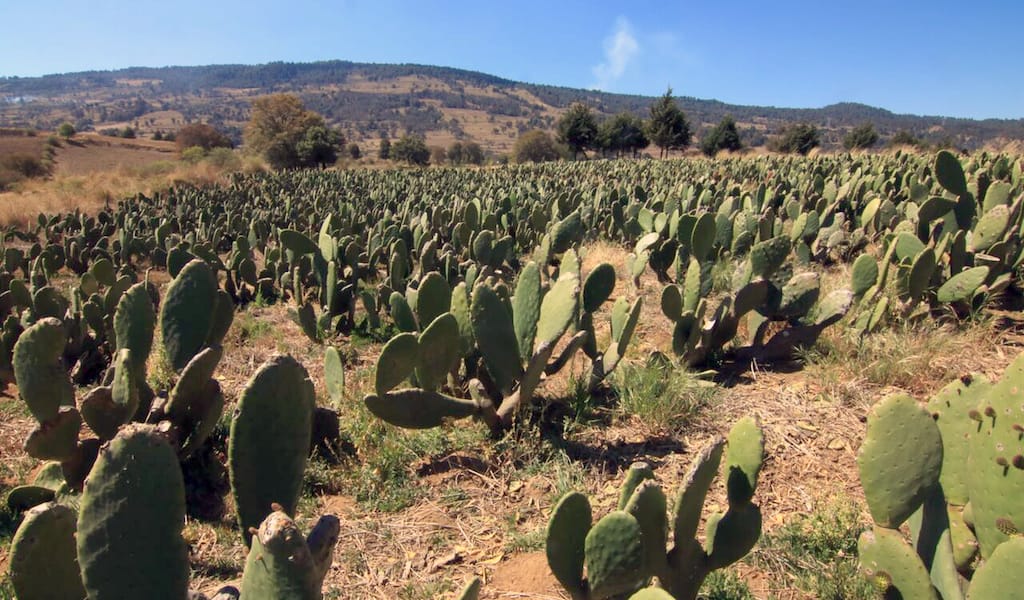We met Don Tirso in the center of Santa Ana Tlacotenco, one of 12 villages in Milpa Alta, Mexico City’s southernmost delegation, on a sunny and cool morning. The road from village to village in Milpa Alta snakes through fields and around ancient volcanoes, slowly climbing up the mountains that overlook the beast of a city to which it formally belongs.
We take a truck to his property, part of a farming cooperative ceded to the campesinos (farmers) following Mexico’s decade-long revolution that ended in 1920, which focused heavily on agrarian reform. In his village, the city’s only rural area covered with forests and farms, his generation of elders is the one that mostly carries the torch of their direct connection to the Aztec past. He learned to communicate bilingually as a young boy, speaking Nahuatl while he worked in the fields with his grandparents, cultivating nopal (the prickly pear cactus) and heirloom corn.
“There are many interesting places in the world, I suppose,” Don Tirso says, adding that he just turned 81. “But the advantage of living here is that you don’t age as quickly as they do in the city.”
 Indeed, he is spry. He shows us around his two-hectare property (just shy of five acres). Here he has various types of squash growing wild, his bees and a few maguey (agave) plants – it’s from the base of the latter that agua miel (honey water) is extracted and then fermented, yielding the pre-Hispanic alcoholic beverage pulque. His children know how to work the land, he says, but like many from the younger generations, they’ve opted to seek careers in the city as professionals rather than farmers.
Indeed, he is spry. He shows us around his two-hectare property (just shy of five acres). Here he has various types of squash growing wild, his bees and a few maguey (agave) plants – it’s from the base of the latter that agua miel (honey water) is extracted and then fermented, yielding the pre-Hispanic alcoholic beverage pulque. His children know how to work the land, he says, but like many from the younger generations, they’ve opted to seek careers in the city as professionals rather than farmers.
We stop next to Don Tirso’s property where his neighbor Don Liborio loads volcanic rocks into a wheelbarrow in his field of nopales. The two men are about the same age, and they speak in Nahuatl.
Milpa Alta, “high cornfield” in Spanish, is the country’s leading producer of the edible nopal and generates about 80 percent of the produce sold in Mexico City. The borough’s farmers make the hours-long trek to bustling city markets daily; you can see them all across the capital, selling nopal, mole (a traditional Mexican sauce), honey and tortillas fresh from their land.
Its soil fertile with volcanic nutrients, Milpa Alta is mostly agricultural. Fields of nopales stretch across the horizon. The cactus is as emblematic of Mexico as sunshine, playing a starring role on the country’s flag. But beyond its symbolism, the nopal is a vitamin-rich superfood. It’s tangy, and appears in everything from barbecue to stews and salads. It’s a common ingredient in jugo verde, or green juice, found all over the country. A nopal farmer will propagate the cactus by placing one of its sliced leaves (resembling pads) directly into the earth. When harvesting and preparing for food, they shave off the sturdy spikes and the thick skin that protect the nopal’s bright green meaty center. It’s typically grilled or eaten raw, and is a ubiquitous feature in Mexico City’s famed street food.
Among Mexico’s most beloved dishes, mole is a sauce containing myriad ingredients and served with nearly anything: from chicken to chapulines (grasshoppers, usually fried). Roughly 60 percent of the mole consumed in Mexico (and nearly 90 percent of that eaten in the capital) is produced in the Milpa Alpa village of San Pedro Atocpan by small mom-and-pop outfits, where you’ll be welcomed to dine in. Just follow your nose to the nearest vendor.
Up the street from where I met Don Tirso lives Doña Susana Revilla Rosas, a renowned archivist of traditional Mexican cuisine. Fridays, Saturdays and Sundays she can be found outside of her home near the town’s cemetery, cooking up all manner of blue-corn related foods on her giant comal, an iron plate that sits above a fire, functioning as a stove top.
“The advantage of living here is that you don’t age as quickly as they do in the city.”
She’s been growing maíz criollo (or heirloom corn, in this case blue) for about 15 years in her backyard. She makes her own corn masa and serves up a local Valley of Mexico specialty: the tlacoyo. Tlacoyos are oval-shaped corn patties stuffed with requesón (a crumbly, mild cheese) frijoles (beans), chicharrón (fried pork skin) or habas (lima beans), topped with runny sour cream, a relatively mild salsa (often red), cheese and nopal.
She and her husband, known as El Jarocho (a nickname given to natives of Veracruz state), also cultivate maguey plants and ferment pulque in their home. Pulque was traditionally the drink of Aztec priests and nobility, then it became a food that mothers gave to their children as a way to fortify their digestive systems – it’s loaded with probiotics and other vitamins straight from the root of the maguey. Pulque ferments depending on temperature, and the process of going from agua miel to pulque can take as little as half a day in high-intensity sun and heat to longer than a week in the rainy and colder seasons.
“My parents gave us pulque to drink when we were kids,” says Doña Susana, laughing. “We didn’t have soda or anything like that. What we drank was pulque. But my kids claimed they never liked it.”
Pulque has a mild alcohol content and was once so popular among the average Mexican that the budding beer companies had to use slander to destroy its reputation in order to get people to drink their lagers. Fortunately, it has become popular again as a drink for adults and even the hipsters in Mexico City.
With a slightly acidic taste and a milky texture, pulque can be found natural or curado, which means it’s been blended with fruit or vegetables. Beyond being a healthy beverage with laxative properties (you’ve been warned), Doña Susana says it’s a typical ingredient in Milpa Alta used to marinade meat and also in place of yeast to make bread.

When To Go: It’s never a bad time of year to visit Milpa Alta, with village festivities going on all the time. But if you really want to have the chance to try the most foods with the least amount of effort, consider the annual Feria Nacional del Mole, a festival which honors the beloved sauce in all of its varieties (and there are seemingly countless) with vendors selling dried mole to take home and temporary restaurants set up within the festival where you can also try local specialties such as guajolote (turkey), escamoles (ant eggs) and fried gusanos (worms) de maguey. The festival takes place this year from October 6-28, in San Pedro Actopan and features traditional dances, carnival rides and local artisanry. Besides mole, another specialty of Milpa Alta are the wild mushrooms which are in season from late July through September, during the rainiest months.
Restaurant Recommendation: Street food abounds in Milpa Alta, especially if you go on the weekend during a tianguis (a roving, indigenous market). The main market in the village of Milpa Alta serves up traditional fare for very cheap prices. If you’re looking for a restaurant, you’ll have to go to San Pedro Actopan, where there are several of high quality, but La Herradura, with its windows open to the pueblo’s picturesque center, is your best bet.
How To Get There: The shortest and easiest way to get to Milpa Alta from other parts of the city is by car – either your own (using GPS apps like Waze and hawklike alertness) or with a taxi or Uber, which you can almost surely find in San Pedro Actopan, just south of neighboring borough and tourist destination Xochimilco. From San Pedro Actopan, you can also take local buses that feature the names of villages in Milpa Alta. For a longer trip, catch the Milpa Alta bus at the Taxqueña subway station and transportation hub. It takes roughly an hour and a half to make it to Villa Milpa Alta, from where you can find buses going to any of the villages. The first village it passes on its way from Xochimilco is San Pedro Actopan.
 January 14, 2019 Going Deep
January 14, 2019 Going Deep
As the calendar year turns over, we’ve grown accustomed to the barrage of lists telling […] Posted in Mexico City, Special category February 14, 2014 Zübeyir
February 14, 2014 Zübeyir
Finding a kebab restaurant in Istanbul is not hard. There must be thousands of them. But […] Posted in Istanbul April 8, 2015 Don Lázaro El Viajero
April 8, 2015 Don Lázaro El Viajero
In the tale of Don Lázaro El Viajero, a Spanish Jew named Lázaro L. Torra, escaping the […] Posted in Mexico City
Published on September 06, 2018
Related stories
January 14, 2019
Mexico City | By Culinary Backstreets
Mexico CityAs the calendar year turns over, we’ve grown accustomed to the barrage of lists telling us where to travel during the next 12 months. Oftentimes these places are a country or even a whole region – you could spend an entire year exploring just one of the locations listed and still barely make a dent.…
February 14, 2014
IstanbulFinding a kebab restaurant in Istanbul is not hard. There must be thousands of them. But finding the right kind of place, especially if you want to make it a bit more of a meal, can be surprisingly difficult. Most kebab joints tend to be no-frills, in-and-out places. Some are very good (and we will…
April 8, 2015
Mexico CityIn the tale of Don Lázaro El Viajero, a Spanish Jew named Lázaro L. Torra, escaping the fascist advance in that nation’s civil war, fled in 1939 to Mexico City – one of tens of thousands that then-President Lázaro Cárdenas invited to find refuge in Mexico amid the black conflict of that war. By 1944…


















































































